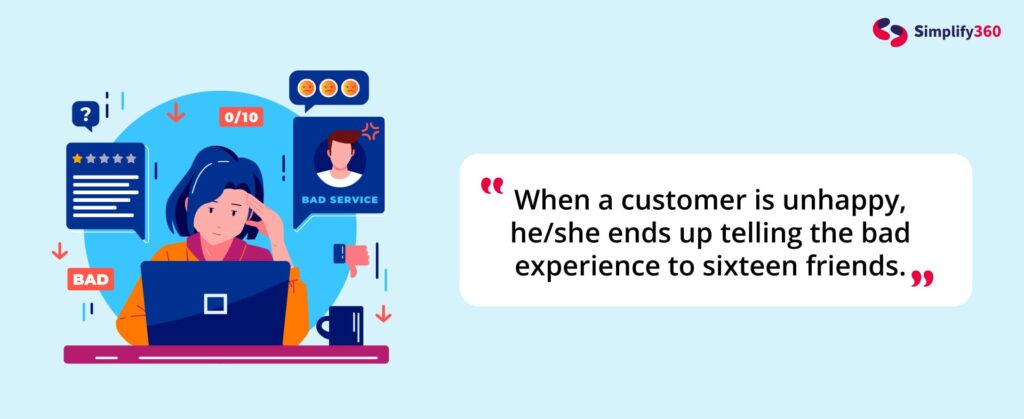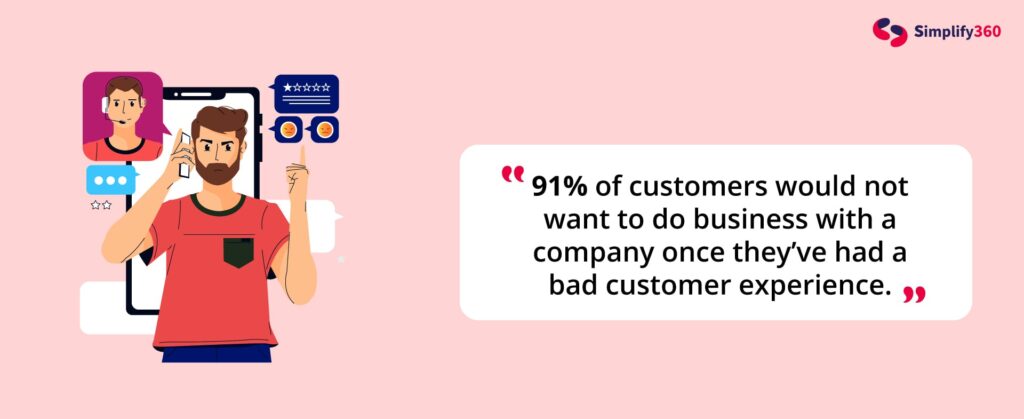Having a hard time dealing with difficult customers? Well, you’re not the only one! Others are reading this article simultaneously as you do!
One moment a customer tells you “Thanks so much! You were really helpful today!”
And the next moment, another customer tells you “This isn’t helping! I need to talk to your manager!🗣️”
This eventually makes you ask the question “how to deal with difficult customers?”
Customer support can be hard. And dealing with difficult customers can be even harder. But it doesn’t have to be that way always!
When you know how to deal with difficult customers, you’re not going to find it that hard. And in this article, we’re just going to see about that!
Before we get started with the ways on how to handle tough clients, there’s a bit of ground we should cover first!
How Dealing With Difficult Customers Can Help Your Business?
Before we get to the good part, let’s talk about what happens when you don’t deal with difficult customers.
- On average, when a customer is unhappy, he or she ends up telling the bad experience to sixteen friends. (GrooveHQ)
- An approximate 91% of customers would not want to do business with a company ever again once they’ve had a bad customer experience. (Glance)
- An approximate 36% of customers share their customer service experience on social media platforms, doesn’t matter whether it’s good or bad. (CFI Group)
You get the idea, right?
“Bad customer service is expensive for your business – both in terms of reputation and finances!”
You never know when an enraged customer starts to share their experience on social platforms. The word spreads and it becomes bad for your business! And that’s exactly why you should consider dealing with difficult customers a top priority!
When you handle an angry customer successfully and provide him or her with the desired solution, you might have just earned a loyal customer for your business! They might even turn as brand advocates and provide free WOM!
Customers love agents who take additional efforts to help them.
Sounds great, right?
Now let’s look at the types of difficult customers you may come across!
4 Types of Difficult Customers
We’ve listed out the most common types of difficult customers here (actually, there are more but we’ve narrowed it down to the most common and important ones). We won’t be looking at how to deal with these types of customers in this section – that comes later.
1. Enraged Customers
We wanted to start with angry customers. Because that’s the most common type of difficult customer you’ll be dealing with!
Angry customers are people who are not satisfied with a particular incident that happened recently with regards to your service or your product!
They might vent out! And they might sound way too harsh. It’s the momentary cause of upset that’s making them behave so!
Quick Tip: Keep your calm while dealing with such types of customers. Remember that the fuss isn’t about you but the issue at hand! When you understand this, you’ll be able to just focus on the issue and not take things personally.
2. Demanding Customers
Met someone who holds their ground strong for something even though it’s wrong? These customers resemble them to a certain extent!
Demanding customers have set their minds on what they want. They are least bothered about whether you can or cannot do it! They want what they want – period!
Quick Tip: Never say no here. At least try not to! It’s not always possible to give what customers want. But the agents should try to work something out and meet them at a middle ground. If it’s reasonable enough, your customers will accept what you offer.
3. Critical Customers
These types of customers are more likely to find fault in your services. And sometimes, they might be right as well! Reasoning out with these customers isn’t going to be as hard as the above two types of customers. Listening to critical customers can even offer you much-needed insights for your business and even identify room for improvement!
Quick Tip: Listen them out. And while you do so, let them know they are being listened to. Keep the conversation engaged and respond to them often. Deal with patience and make sure you hear everything they have to tell. They accept the possibilities – all you have to do is, make sure the solution is reasonable.
4. Indecisive Customers
Indecisive customers are people who have second thoughts or are not sure about what they want.
Dealing with indecisive customers can be time-consuming but you have every opportunity to get in their good books. All you have to do is, genuinely address their concerns and provide an appropriate solution for their issue.
Quick Tip: Limiting the options you offer to indecisive customers is one way to help them decide quick. But make sure you be fair to them. Just because they are looking for your suggestion doesn’t mean you can exercise freedom here. After all, it’s your reputation at stake. Hear out their concerns and offer a genuine solution.
So, those are the most common types of difficult customers you’ll be dealing with! Once you know how to categorize your customer, you will know how to deal with them!
Now that we’ve covered the basics, let’s get to the main part of the read (we’ve listed them out in sequential order – more like a journey kind of approach).
8 Ways to Deal With Difficult Customers
1. Don’t Hesitate to Engage With Difficult Customers
This is the first and foremost topic we’re going to look at – not hesitating to deal with difficult customers.
We just discussed how good it can be for your business when you handle tough clients. When you come to know that there’s a difficult customer to deal with, don’t shy away from the conversation – take it up boldly and deal with the issue!
When you start dealing with difficult customers consistently, you not only grow as an efficient customer support agent but your company will also grow more customer-centric and build a loyal customer base.
Whether you are able to resolve the issue or not is secondary. The first thing you have to do is face them!
2. Be Professional At All Times
Now that you’ve started dealing with difficult customers, the first thing you should do is, stay professional at all times! And staying professional includes keeping a check on your communication and staying calm & collected!
Check Your Communication – How you communicate plays a major role when handling angry customers. Make sure that your tone is professional, friendly and most importantly, respectful. The way you communicate is more like a first impression for your customers – staying professional can prevent them from further getting agitated!
Stay Calm & Collected – Another important aspect of being professional is staying calm always no matter what and going with the flow. When you stay calm and speak softly, even angry customers reciprocate with you and tone down their voices.
Being professional is one of the most important qualities you should be having as a support agent, especially when dealing with difficult customers.
3. Allow Your Customers To Talk
Give all the time your customers need to explain their issues. Interrupting in-between only aggravates them making the situation even worse!
When customers know you are listening to them, you’re making progress. They are more likely to soften their voice and handling them becomes much easier!
While listening to your customers, understand what their concerns are! A customer who has to repeat themselves over and over will only get more frustrated. So, pay close attention to what your customers are saying – can save you both time, effort and from further escalation!
4. Show Them You Understand. Be Empathetic.
It’s not only enough that you understand! But you should also show your customers that you understand!
How? By practicing “Active Listening.”
Active listening is an approach that will help you out here! All you have to do is, come up with simple responses like,
- I can totally understand.
- I hear you.
- I get the picture.
- I understand how you feel.
Or even a simple “mmmm” should do the job! Make sure your responses are not interruptions but only acknowledge statements.
Reciprocating and engaging your customers softly and politely will force them to speak the same way as you do.
Also, make sure you empathize with your customers. Put yourself in their shoes and try to understand what your customers are facing. Ask your customers what their issue is first to get a clear understanding – never assume or try to figure it out on your own! The last thing your customer needs is a support agent who has got the wrong idea about their issue.
Come up with questions like,
- I am so sorry you are facing such a hard time! To assist you better, can you please clarify a couple of things for me?
- We are so sorry you had to go through this! To help you better, can you please answer a few questions first?
This shows customers that they are being taken seriously. And you on the other hand can get more insights and start resolving the issue!
5. Offer a Solution
Sometimes, the solution is right in front of you – no brainstorming is needed! All you have to do is, ask what the customer wants!
If what they ask is possible, simply give them that – no further questions or interactions. This approach works best when the customer already knows what they want! But when you come across indecisive or critical customers, you’ll have to assess their needs and come up with the best solution for them.
At times, they agree with what you offer. At times they do not! That’s when you’ve got to do the following!
State What You Can & Cannot Do: As a customer support agent, there are only certain things you can do and offer. When a customer demands something that’s above your reach, you should clearly explain what your limitations are and what you can do. Go a step further and share the company policies if that would help.
Reach a Middle Ground: Once you’ve clearly explained to the customer, try to reach a middle ground. Let the customer know what you can offer them instead of what they’re asking for. But make sure what you offer is reasonable. And it’s an offer they cannot refuse!
When you do the above two things right, there’s a high chance that the customer will agree to what you’re saying! And always make sure you’re professional and humble – it’s going to work only then!
Pro Tip: Sometimes, most of your customers end up having the same question – this could be a trivial one or something that doesn’t need the intervention of an agent. Deploying AI chatbots can help customers self-service themselves during such scenarios. Make sure you integrate FAQs and helpful articles and also an option to speak with an agent. With AI chatbots in place, your customer support staff can be more productive and deal with more complex issues!
6. Escalate When Specifically Asked For
When your customer is not satisfied with what you offer, the next step is going to be an escalation request! This happens often when you deal with angry or demanding customers!
They come out lashing with phrases like,
- This isn’t working! I need to talk to your manager!
- I need to speak to a higher authority! Connect me to your manager!
When this happens, don’t hesitate to escalate the call! The idea is to satisfy the customer, not to prevent call escalations.
Two things happen here. When you escalate the call,
- The customer knows they are being taken seriously, allowing them to settle for a solution.
- They walk away happy knowing they’ve got great customer support.
The word spreads and it’s good for your business. While some support agents think that escalation will look bad on them, it’s the total opposite – you’re doing the best for your customers and that’s all that matters at the end of the day!
7. Offer An Apology. Probably More Than Once.
We wanted to bring this topic to the later sections of the read so we can tell you how important it is!
When it comes to customer service, don’t hesitate to offer an apology – it doesn’t matter whose side the fault is on, offer an apology instantly.
This can help diffuse the tense atmosphere that’s prevailing between you and the customer. When you apologize, majority of the customers automatically soften their tone and start working towards a solution!
And while making an apology, make sure you sound like you mean it!
What Doesn’t Work – Hi, Sorry this happened!
What Works – Hi John. We are sorry to hear what you’re experiencing. My sincerest apologies. I’ll make sure this is fixed for you right away!
Coming up with sincere apologies can make the overall “dealing with difficult customers” process an easy one for you! You can also consider offering a gift card or a service extension to compensate for the hard time they had to face!
Now, let’s head to the last tip on how to handle tough clients!
8. Be Prepared. Train Yourself for the Worst.
When taking up a customer service role, you should accept the fact that you’re going to face tough situations now and then!
You should be good in anger management, stress management, negotiation skills and finally, handling angry customers.
Like we said, some customers might come right at you so harshly that you’d want to reciprocate the same way! But that’s not going to work – your company’s reputation will be at stake!
If you feel the conversation is going nowhere and you need a break, transfer the call to another agent. Before doing it, inform the customer politely that you’re bringing another agent on board so that they can get the best help.
Having such skills can help you handle tough situations with ease. Remember that you’re a human and it’s normal to get frustrated. But how you handle the same matters when you are a customer support agent!
So, those were the eight tips on how to deal with difficult customers! Here’s a quick summary of the same,
- Don’t hesitate to engage with difficult customers – they are an opportunity to grow your company’s reputation and identify business opportunities.
- Stay professional no matter what – keep calm and stay collected.
- Give your customers all the time they need to explain their issues.
- Reciprocate politely and show them you understand their concerns.
- Work out the best possible solution and present it to them.
- Escalate when asked – don’t think twice.
- Offer an apology – even when it is not needed.
- Be prepared. Train yourself to deal with difficult customers
So, that’s pretty much it! We’ll wrap this read now!
Final Few Words
Angry customers or demanding customers – it doesn’t matter because they’re a great opportunity to showcase how good your company’s customer service is! A difficult customer handled properly turns into loyal brand advocates and provides free Word-of-mouth marketing.
They are more like an opportunity to showcase how much you care about them and how customer-centric your company is!
Now that you know how to handle tough clients, why wait? This year, make dealing with difficult customers your top priority. And try converting all of them to loyal brand advocates!





